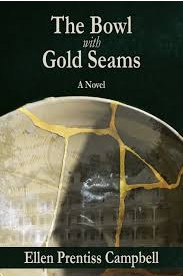Book Review: The Bowl with Gold Seams
I’ve written frequently about my admiration for small-press publishing, folks who are driven more by their love of the written word than by any expectation of making a commercial killing. It’s that willingness to simply go with what they love that leads many small presses to build impressive catalogs of work by authors of remarkable talent. This month I’m highlighting another example of this marriage of small press to big talent.
 I originally heard about Ellen Prentiss Campbell from several sources almost simultaneously, one of which was our shared publisher. As small presses go, publishers don’t come much smaller than Apprentice House Press, run out of Loyola University. Of unique note, though, Apprentice House is both non-profit and student-run. Students learn by doing; authors get unparalleled input into the creative process behind bringing a traditionally published work into print. What is perhaps most remarkable is that the students work as a team to choose the projects for which they’d like to offer a contract. Kudos for their selection of Ellen’s novel.
I originally heard about Ellen Prentiss Campbell from several sources almost simultaneously, one of which was our shared publisher. As small presses go, publishers don’t come much smaller than Apprentice House Press, run out of Loyola University. Of unique note, though, Apprentice House is both non-profit and student-run. Students learn by doing; authors get unparalleled input into the creative process behind bringing a traditionally published work into print. What is perhaps most remarkable is that the students work as a team to choose the projects for which they’d like to offer a contract. Kudos for their selection of Ellen’s novel.
THE BOWL WITH GOLD SEAMS, Ellen Prentiss Campbell, Apprentice House, 2015, 221 pp.
“What is broken is also beautiful.” This is the lesson taught by kintsugi, a Japanese ceramic art form in which objects are purposely broken and then mended with golden joinery, thereby making them even more beautiful and more valuable.
In Ellen Prentiss Campbell’s gorgeous, quietly nuanced debut novel, The Bowl with Gold Seams, it is time and experience that combine to mend that which has been broken in the main characters.
 The novel’s basis is a brief footnote in World War II history. When they rolled into Berlin, the Americans captured Japan’s ambassador to Germany and his retinue as they attempted to flee. Close advisor to Hitler, Hiroshi Oshima was considered valuable bargaining collateral in negotiating for release of American POWs as the war in the Pacific dragged on. The entire captured embassy staff and their families were taken to the U.S. and interred at the already-historic Bedford Springs Hotel in tiny Bedford, Pennsylvania.
The novel’s basis is a brief footnote in World War II history. When they rolled into Berlin, the Americans captured Japan’s ambassador to Germany and his retinue as they attempted to flee. Close advisor to Hitler, Hiroshi Oshima was considered valuable bargaining collateral in negotiating for release of American POWs as the war in the Pacific dragged on. The entire captured embassy staff and their families were taken to the U.S. and interred at the already-historic Bedford Springs Hotel in tiny Bedford, Pennsylvania.
Campbell’s approach to relating this story is intriguing, with a long prologue and epilogue in the story’s present day that bookend the main story of young Hazel Miller, raised as a Quaker by her father in Bedford between the wars. He runs the town’s jail according to Quaker principles, instilling in Hazel the concept that “people can do bad things without being bad people.”
She and Neal Shaw find each other on the first day of school; after graduation, they marry just before he ships out for the Pacific. Almost immediately, he is listed as missing in action. When it’s announced that the ambassador and staff will be held at the hotel, Hazel decides to take a job there. She finds herself intrigued by the Harada family: Japanese Takeo, reserved, severe, and as beautiful as a marble sculpture; his statuesque, high-strung, and musically talented British wife Gwendolyn, and their lonely thirteen-year-old daughter Charlotte who is trapped between two worlds.
With spare language and a clear-eyed approach to exploring difficult themes, Bowl packs an emotional punch. Characters are flawed and human, and the author avoids caricatures of virtue or villainy. The anger and suspicion of the locals at having the Japanese among them is palpable, and understandable given the still-active fighting and recent horrors of Bataan. Hazel starts out wondering how she will be able to tell these exotic-looking foreigners apart, but quickly learns to see and treat them as individuals.
In particular, she takes Charlotte under her wing, despite Takeo’s initial disapproval. He’s concerned that his daughter’s mixed heritage makes her stand out too much already, and wants to protect her from being “the nail that sticks out” and therefore “gets pounded back in.” But Hazel is drawn to Charlotte, the product of two warring parents who belong to two warring countries. Hazel comes to grasp the natural affinity between the Quaker and Asian philosophies of finding beauty in simplicity, and in using stillness and shared silence as a tool for divining a path forward.
In the prologue, Hazel and Charlotte are brought together again through Hazel’s position as the head of a Quaker school, just as the school is hit with a crisis that places Hazel at odds with the school’s board in discerning the best path for all concerned. She and Charlotte decide to visit Bedford Springs together and face their shared past, even as Hazel understands that she’ll need to confront the outcome of choices she has made.
The Bowl with Gold Seams is a reminder that first recognizing and then choosing the right path is a life-long effort that takes courage and a willingness to learn from earlier failures, to work actively to heal what is broken. The seams may show, but there is beauty in that, too.
****
Be sure to join us on 1 December when we welcome Ellen Prentiss Campbell as our guest blogger; she’ll be discussing the power of well-chosen books.
Jennifer Bort Yacovissi
Jenny Yacovissi grew up in Bethesda, Maryland, just a bit farther up the hill from Washington, D.C. Her debut novel Up the Hill to Home is a fictionalized account of her mother’s family in Washington from the Civil War to the Great Depression. In addition to writing historical and contemporary literary fiction, Jenny reviews regularly for the Washington Independent Review of Books and the Historical Novel Society. She belongs to the National Book Critic’s Circle and PEN/America. She also owns a small project management and engineering consulting firm, and enjoys gardening and being on the water. Jenny lives with her husband Jim in Crownsville, Maryland. To learn more about the families in Up the Hill to Home and see photos and artifacts from their lives, visit http://www.jbyacovissi.com/about-the-book.
- Web |
- More Posts(33)